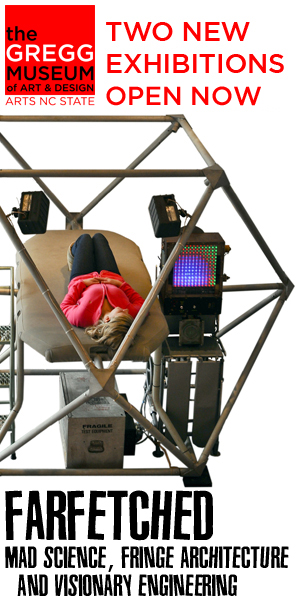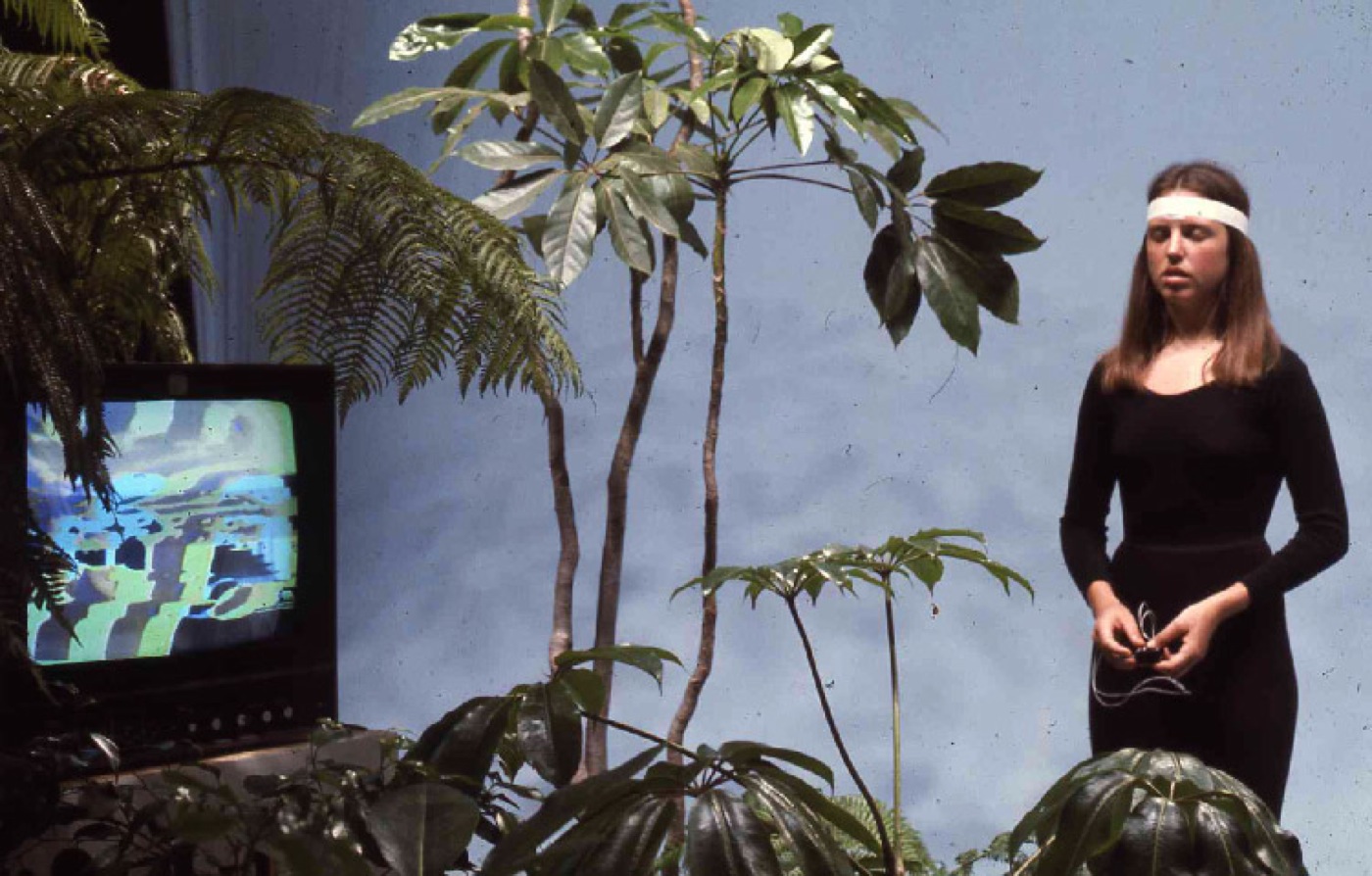On March 23rd I made my way to Atlanta, Georgia to be the guest of Craig Dogonski at Georgia State University where he and his wife Pam Longobardi are resident professors of art. It was also the weekend of the Atlanta Science Festival. Pam had a big role in that Festival having conceived Plastic Gyre, a forum for artist and scientist activists to raise awareness of the growing problem of plastic pollution in our oceans.
Craig and I were scheduled to stage a far more modest demonstration at his gallery, Whitespace. Our contribution to the ‘science’ festival would be to hook up plants and rocks to various detectors, including brain wave equipment, change the small voltages therein to pitch, and orchestrate the result as electronic music.

[ Craig Dogonski ]

[ Craig’s mysterious artwork ]
I had never met Craig before now, but for years he had been trying to find a way to get me to Atlanta. Now here I was, making a three hour presentation to his graduate students, doing a TV interview together for GSU Public Broadcasting, then the performance at Whitespace—all on the first day. Day two was morning crits with his large undergraduate class, followed by one on one follow up studio visits. Day three was a big luncheon at GSW for Pam’s forum, then a visit to the Language Research Center at GSU where Craig has developed a long and fascinating relationship with the resident chimpanzee population doing visual art.

[ Laurie Presentation ]

[ Undergraduates taking a break with improvisational theater exercises ]

[ Craig digging some sounds ]
Both Craig and I have been working for years with the IBVA Brain Machine. Craig uses it mainly for orchestrating brainwaves, while Gordon and I focused on generating sounds from plants and rocks. In addition, for the demo, I schlepped Gordon’s Wheatstone Bridge and Rate of Change Converter to Atlanta. The Whitespace demo/performance was crazy. Just as the film crew were setting up to record our transformation of plant voltages into music, my computer went dark screen. In retrospect, I believe it was plant retribution for insisting the plant do things it wasn’t properly prepared for. Plant music is a delicate task. Crowds of people plus show and tell are not an ideal venue for coaxing a beautiful melody from a Rhododendron. I have seen equipment shut down like this before, when the wrong vibe is in the mix. Soon, Craig’s computer crashed too. His came back in a hour, but mine took a week including a trip to the shop. (No evidence of damage.)

[ Duncan and Craig setting up at Whitespace, Atlanta ]


[ Duncan and Craig performance and lecture at Whitespace, Atlanta ]
Working with Chimps
To quote their website:
“Researchers at Georgia State University’s Language Research Center examined how two language-trained chimpanzees communicated with a human experimenter to find food. Their results are the most compelling evidence to date that primates can use gestures to coordinate actions in pursuit of a specific goal.”
And consider this:
“Humans’ closest animal relatives, chimpanzees, have the ability to “think about thinking” – what is called “metacognition,” according to new research by scientists at Georgia State University and the University at Buffalo.” Craig, in turn, built upon the capacity chimps have for ‘metacognition’ to explore their capacity to mimic writing and make art.
The simplest way to grasp that amazing experience is through Craig’s video, “Dongoski Poem for the End”
Dongoski Poem for the End from Craig Dongoski on Vimeo.

[ Craig with marks made by his long time chimpanzee collaborator, Panzee, who died last year ]

[ Paintings by Craig and chimpanzee collaborator, Sherman ]

[ Panzee ]

[ The careful writing Panzee made (original rendering) ]


[ Panzee writing ]
I wasn’t allow to photograph the chimps currently in residence at the Language Center, nor get very close to them, but I was grateful for seeing their world and the place Craig has spent so many enjoyable afternoons.
The trip was winding down, but we had both enjoyed a wonder filled and creative meeting of the minds. I would leave the area soon, but not before I invited Craig to meet Ed Kelly at Kelly Research Technologies, Inc. in Lakemont, Georgia.
KRT
I knew Craig had a passing familiarity with Radionics, but there is nothing like visiting a lab where the machines are being built and classes taught. Ed Kelly’s father, Peter, had been my instructor on how to use a radionic instrument in this same dome lab some 30 years before. He had also introduced us to his new, recently upgraded BETAR sound system. The original BETAR had been purchased by the late R. J. Reynolds III and subsequently installed in my studio in Long Island City, New York. That device we still use and hack. Over subsequent decades it became The Music Machine and later, The Purr Generator. The Purr recently spent a year on display at the American Visionary Art Museum in Baltimore and had a follow-up sojourn at The Gregg Museum at North Carolina State in Raleigh.
Now, we were back at the origin of that long sonic journey of three decades. Ed was gracious enough to give us an afternoon of his and his sister Erin’s time to forge a new connection. Craig was blown away, and Ed immediately saw the potential of IBVA in demonstrating the efficacy of certain products he was making. My hope was that through Craig and Pam’s friends in the environmental movement, Ed’s work with agricultural radionics would get some much needed attention. Call it “Another fine afternoon of mad science & art”!

[ Kelly Research Technologies, Inc. ]

[ Interior of Kelly Research Technologies, Inc. ]

[ Ed Kelly with a new radionic antenna design ]

[ Ed’s redesigned BETAR ]

[ BETAR flyer ]
[ BETAR promo video! ]

[ Craig demos the IBVA to Erin, Ed's sister ]

[ With my brain in the hot seat! ]
March, 2015 Duncan Laurie


 Duncan was interviewed on Frank Stasio's
Duncan was interviewed on Frank Stasio's 